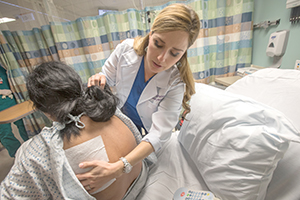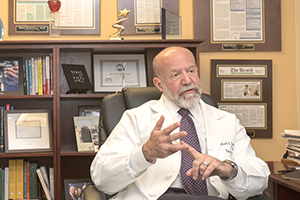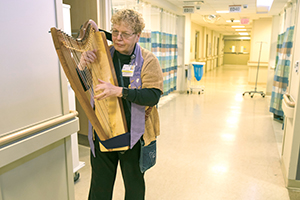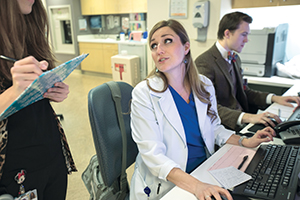Goal is to reduce use of opiates in the ER
By BETSY TAYLOR
PATERSON, N.J. — It's a Monday morning at St. Joseph's Regional Medical Center, and the emergency department is hopping. Patients arrive sick, injured and in pain, whether from a heart ailment or a wrenched back, from sickle cell disease or kidney stones.

Dr. Alexis LaPietra checks a lidocaine patch that delivers a local anesthetic to Dilia Lascarro Nieto of Garfield, N.J. Nieto came to St. Joseph's Regional Medical Center in Paterson, N.J., in early November complaining of pain in her chest and back. She was given non-opioid pain relief medications, as part of the emergency department's commitment to use alternatives to opioids, when possible.
Photo by Jennifer Brown
All of these patients — those lined up at the admissions desk and others transported in by ambulance — are seeking care and pain relief at an emergency department that in January of 2016 set out to manage acute pain without prescribing opioids whenever possible.
New Jersey, like much of the nation, is struggling with an epidemic of opioid abuse and addiction. More Americans than ever before died in 2015 from drug overdoses, and 33,091 of those deaths involved opioids, according to a December data analysis from the Office of National Drug Control Policy. These deaths are from drugs sold on the street like heroin and heroin cut with fentanyl, a synthetic opioid; and also from prescribed opioid pain medications. In New Jersey, the drug-related death count started to mount six years ago, with about 1,300 people dying from opioid-involved overdoses in 2015, the most recent year for which figures are available from the New Jersey medical examiner's office.
Dr. Alexis LaPietra is the medical director of emergency medicine pain management for St. Joseph's Healthcare System, the system that includes St. Joseph's Regional Medical Center. She opposes the widespread practice of prescribing opioids as a first-line response to pain: "It's almost like using a sledgehammer to sink a cork." And the ripple effects can capsize the lives of individuals who become addicted to the pain medication or take it differently than prescribed.
For increasing numbers of Americans, prescription drugs serve as their first exposure to addictive substances and provide a "first stepping stone to future addictive use," writes Dr. Anna Lembke, a psychiatrist and the chief of addiction medicine at Stanford University School of Medicine in her 2016 book Drug Dealer, MD: How Doctors Were Duped, Patients Got Hooked, and Why It's So Hard to Stop. She writes that the majority of new heroin users "cite prescription opioids as their first exposure to opioids, a clear generational shift."
No more sledgehammer
St. Joseph's Regional Medical Center care providers researched best practices to find alternatives to opioids while still aggressively managing pain in the emergency room. Physicians say the change in approach to pain management at St. Joseph's Regional Medical Center has benefited patient care and created a culture change where they're more mindful about the risks and benefits of prescribing opioids in every instance.

Dr. Mark Rosenberg is a champion of St. Joseph's Regional Medical Center emergency department's cohesive effort to treat pain with alternatives to opioids. He chairs emergency medicine for St. Joseph's Healthcare System.
Photo by Jennifer Brown
Opioids continue to have appropriate uses, including for severe cancer pain or for patients in intense pain related to a recent physical trauma, said Dr. Mark Rosenberg. He chairs emergency medicine for St. Joseph's Healthcare System and is its medical director of population health. But the pain associated with certain fractures can be successfully controlled with ultrasound-guided nerve blocks. And some back pain responds well to trigger point injections, he said.
Dr. Kristy Ziontz oversees the care of patients under observation in the ER. She said under the new protocols, she'll get a physical therapist involved early in treatment of a patient with back pain, to assess if strengthening exercises and movement might address the root cause of the pain and be beneficial to healing. In the past, the same patient might have been prescribed bed rest and be sent home with a prescription for an opioid painkiller.
An emergency department physician, Dr. Marco Propersi treated a patient in November who was suffering the excruciating pain of acute sickle cell crisis. Propersi first tried the patient on "a ketamine drip" — an intravenous dose of the anesthetic drug — before prescribing an opioid, Dilaudid, because the patient remained in pain after the first medication.
People's choice
St. Joseph's may have as many as 150 patients in its emergency department at any one time. Patient feedback about trying treatments other than opioids has been positive. "I don't think I've had any complaints at all," Propersi said. "People here for medical issues want to feel better," he said, and doctors are using effective approaches to manage pain.
LaPietra checks in on one of her patients, Dilia Lascarro Nieto of Garfield, N.J., who came to the ER complaining of chest pain and back pain. LaPietra started her on acetaminophen, an anti-inflammatory and a lidocaine patch, which numbed her back pain. LaPietra said these medications "get to the root of" the patient's pain, without the sedating effects of an opioid that can compromise a patient's breathing.

Harpist Edie Elkan performs in the emergency department halls at St. Joseph's Regional Medical Center, sometimes lulling pain patients to sleep.
Photo by Jennifer Brown
A Spanish speaker, Nieto said she was worried about what doctors would tell her about her heart, but felt better than when she first arrived. "Bueno, bueno," she said by way of description.
Turning the tide
St. Joseph's emergency department began its Alternatives to Opioids Program with the three-pronged goal of keeping people from becoming dependent on opioids, offering drug-seeking addicts a path to rehabilitate from their addiction (see below), and reducing the supply of prescription opioid drugs being resold on the streets.
Rosenberg said in the first year of the new program, the emergency department prescribed opioids about 50 percent less than doctors here used to. Rosenberg said physicians at the hospital supported the changes: "This did not require a sales pitch to the doctors in our department," he noted. "This has been a major culture change."
Doctors here said St. Joseph's is part of a nationwide reset in thinking about the use of opioids for pain management. Government and health care organizations around the U.S. stepped up efforts in 2016 to combat opioid addiction, while also highlighting that pain still must be appropriately treated.
The Centers for Disease Control and Prevention, as one example, issued new guidelines for prescribing opioids last year — saying that health care providers in 2012 wrote enough opioid prescriptions for every adult in the nation to have a bottle of the pills. However, the CDC said few studies have been done to rigorously assess the long-term benefits of opioids for chronic pain, or pain lasting greater than three months or past the time of normal tissue healing. Furthermore, from 1999 to 2014, more than 165,000 people in the U.S. died from opioid pain medication-related overdoses. It's a health crisis many years in the making.
Rosenberg said "his hope and dream" is that the Alternatives to Opioids Program helps launch a new standardized approach to how pain is managed in trauma care and acute care settings.
|
Opioids have powerful pull on patients and can be gateway to addiction
PATERSON, N.J. — In the 1990s, experts in pain management, who were concerned that pain was being undertreated, supported the use of opioids to alleviate pain. They considered it highly unlikely that patients would become addicted. That flawed understanding, however, was first based on a relatively small study, said Dr. Mark Rosenberg, who chairs emergency medicine for St. Joseph's Healthcare System.

Dr. Alexis LaPietra, medical director of emergency medicine pain management for St. Joseph's Healthcare System, consults with a staff member on a busy day in the emergency department at St. Joseph's Regional Medical Center in Paterson, N.J.
Photo by Jennifer Brown
In 2001, The Joint Commission established pain management standards and directed clinicians to consider pain as the fifth vital sign — the other four being heart rate, temperature, respiratory rate and blood pressure — gauge the state of a person's essential body functions. Many physicians used a poster depicting happy, sad, grimacing and tearful faces and a one to 10 numeric scale to ask patients to report their level of pain. Dr. Anna Lembke in her recent book Drug Dealer, MD: How Doctors Were Duped, Patients Got Hooked, and Why It's So Hard to Stop explains that pain "unlike the original vital signs, cannot be objectively measured." She said data show that the use of such pain scores actually increases opioid prescribing and opioid use.
Gateway prescription drugs
Dr. Alexis LaPietra, medical director of emergency medicine pain management for St. Joseph's Healthcare System, said about 40 years ago, roughly 90 percent of people in treatment for heroin addiction developed a heroin problem by first trying heroin.
There's been a dramatic shift. In the last couple of years, about 75 percent of those in treatment for heroin addiction said they first tried opioids when they were prescribed them by a physician. The shift, she said, is that "heroin no longer leads to heroin. It's prescription opioids, like Percocet or Vicodin, that lead to heroin."
That knowledge drove the decision by emergency room physicians at St. Joseph's including LaPietra to use alternative pain control procedures and non-opioid drugs where possible to palliate pain.
The body doesn't care whether a person is taking opioids from a prescription filled at a pharmacy or bought on a street corner. Either way, opioids are much more powerful than the body's normal endorphins, which have been called the body's natural opiates. The brain reacts to opioid drugs by decreasing the amount of endorphins it manufactures. Rosenberg explained that in addition to pain relief, opioids can alleviate social anxiety and make a person feel stronger, or surer of himself.
Slide into addiction
LaPietra said, after about 10 to 14 days of opioid use, the brain stops making its own supply of natural opioids. The body begins to become physiologically dependent on the opioid, though "that doesn't mean the person is emotionally dependent," she noted. Physiological and emotional dependency are components of addiction.
The American Society of Addiction Medicine explains addiction as a primary, chronic and relapsing brain disease characterized by an individual pathologically pursuing reward and/or relief by substance abuse and other behaviors. It says in 2015, 2 million Americans had a substance use disorder involving prescription pain relievers, and 591,000 had a substance use disorder involving heroin.
The slide into addiction can begin when a patient takes the drug to feel euphoria as opposed to taking it as prescribed for pure pain relief, the St. Joseph's doctors said.
Addiction's new face
It's difficult to say exactly who will become addicted to opioids as a number of variables come into play. But, "when a person starts to expend more energy in seeking a substance than on their normal acts of daily living, that's a red flag," LaPietra said. Rosenberg said people abusing opioids may engage in practices that harm themselves and others — whether stealing, selling their bodies for sex or using dirty needles — often behaving in reckless ways they wouldn't have contemplated before the addiction.
Many of those rushed into the St. Joseph's emergency department for opioid addiction either miscalculated the amount of an opioid they took or mixed an opioid with other substances that depress the central nervous system like benzodiazepines and alcohol, chasing a better high.
Addiction is a disease, a treatable one, and, in some cases of opioid addiction, a preventable one, the doctors said. And they hope their efforts to limit the use of prescription opioids in the St. Joseph's emergency room will contribute to a national shift where physicians consider every patient as a person with the potential to become addicted to opioids.
"We've created a new face of addiction. It's everyone," LaPietra said.
— BETSY TAYLOR
|
|
Saved from overdose, addicts get a second lifeline
PATERSON, N.J. — Alfred Smith was 43 and homeless when he overdosed on heroin in a Paterson alley April 20. He fell unconscious between garbage pails, he said. A stranger called 911; emergency medical technicians revived Smith with naloxone and rushed him to St. Joseph's Regional Medical Center.
As part of a state-funded Opioid Overdose Recovery Program, a health care provider at St. Joseph's called in a recovery specialist from Eva's Village, a nearby social services nonprofit. That recovery specialist, Arlene White, visited with Smith in person shortly after he regained consciousness in the emergency room and shared her own story of addiction and recovery.

Alfred Smith of Paterson, N.J., credits Eva's Village recovery specialist Arlene White for getting him into an opioid recovery program when he was most receptive to rehabilitation.
Photo by Don Sherrill
She asked him a variation of: "What can I do to help you?" He said he was ready to start treatment to get clean. She assisted him, coordinating the next steps so he could go directly from the hospital to a residential opioid recovery program at Eva's Village. White still stays in contact with Smith, supporting his recovery.
White got him help when he was ready to accept it.
"It saved my life," Smith said.
Smith, who has been opioid-free since his overdose, now has a full-time job loading trucks at a warehouse. He lives in a halfway house run by Eva's Village.
New Jersey started the Opioid Overdose Recovery Program in 2015. Eva's Village became the program coordinator in Passaic County — where Paterson is located —last year under a grant from the New Jersey Department of Human Services, Division of Mental Health and Addiction Services.
Recovery specialists working in Eva's Village Opioid Overdose Recovery Program receive 36 hours of education before they begin outreach interventions at St. Joseph's and other hospitals in Passaic County. (Recovery specialists with a personal history of addiction are evaluated to make sure they are stable in their own recovery.)
The recovery specialists learn how to talk about their own "lived experience" with addiction — as a user or by virtue of a close relationship with an addict. Their aim is to convince a patient fresh off an overdose to enter a recovery program. They attempt to search out an open slot immediately if the patient is ready and willing to get started. The recovery specialists follow up with each person for at least nine weeks after the initial meeting.
The recovery specialists are supervised by a licensed clinician with a master's degree. Recovering addicts in treatment at Eva's Village may receive medication-assisted therapy along with other kinds of therapy.
Eva's Village employs 20 recovery specialists, with eight dedicated to the Opioid Overdose Recovery Program. Michael Santillo, director of integrated care services for Eva's Village, said the program responds to calls from hospitals 24 hours a day.
In the first six months of Eva's Village Opioid Overdose Recovery Program, specialists responded to 217 calls from St. Joseph's emergency room. Of those calls, slightly more than 50 percent of the people the recovery specialists met with went into treatment.
"There's no question it's making a difference, and a substantial difference," Santillo said of the hospital-based interventions.
Annually, more than 2,000 people find a path to substance abuse recovery through Eva's Village's inpatient and outpatient treatment programs, its mental health program and its recovery community center.
— BETSY TAYLOR
|
Copyright © 2017 by the Catholic Health Association
of the United States
For reprint permission, contact Betty Crosby or call (314) 253-3490.